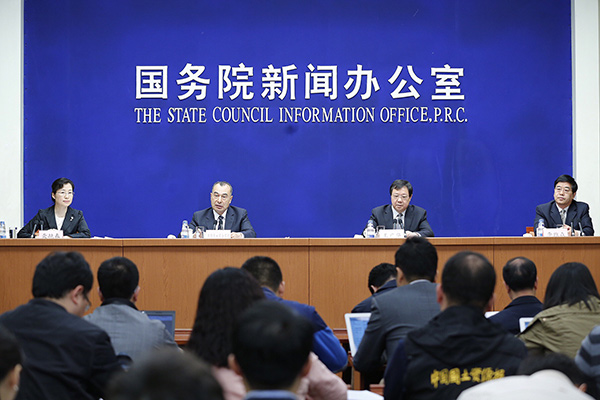
A press briefing on the results of China’s first national geological survey is held at the State Council Information Office on April 24. From left, Xi Yanchun, of the State Council Information Office, Kuresh Mahsut, director of the National Administration of Survey, Mapping and Geoinformation (NASG), Wang Guanghua, vice-minister of Land and Resources, and Li Weisen, deputy director of NASG, were among those in attendance. [Photo/Xinhua]
BEIJING — China boasts a total of 7.56 million square kilometers of vegetation cover, while buildings cover 153,000 square kilometers of land, the State Council Information Office unveiled at a press briefing on April 24.
The numbers are part of the 770-terabyte results of China’s first national geoinformation survey, which collects basic information about the country’s natural resources, such as their location, range and area.
Information of manmade construction, such as roads and neighborhoods, are also included in the results, said Kuresh Mahsut, director of the National Administration of Survey, Mapping and Geoinformation (NASG).
The survey started in January 2013 and lasted three years, with the help of more than 50,000 people and technologies such as remote sensing satellites, drones and 3D laser scanning.
The results underwent months of analysis and approvals before being publicized.
The surveyors combined aerial photography and on-site verification in order to provide more precise information and improve the survey’s quality, said Li Weisen, deputy director of the NASG, which led the work.
According to officials and experts, the survey relates closely to people’s daily lives.
“Based on the results, making the most of the statistics is key,” Li said, adding that the information will immediately serve China’s economic and social development.
For instance, in Beijing and neighboring Tianjin and Hebei, surveyors focused on monitoring the sources of air pollution, the expansion of urban areas and other information.
“The specific numbers help local authorities make more precise decisions to solve the problems,” said Cheng Pengfei, president of the Chinese Academy of Surveying and Mapping.
The results of the survey will be made available to public departments, to enable them provide better public services, Li Weisen added.
